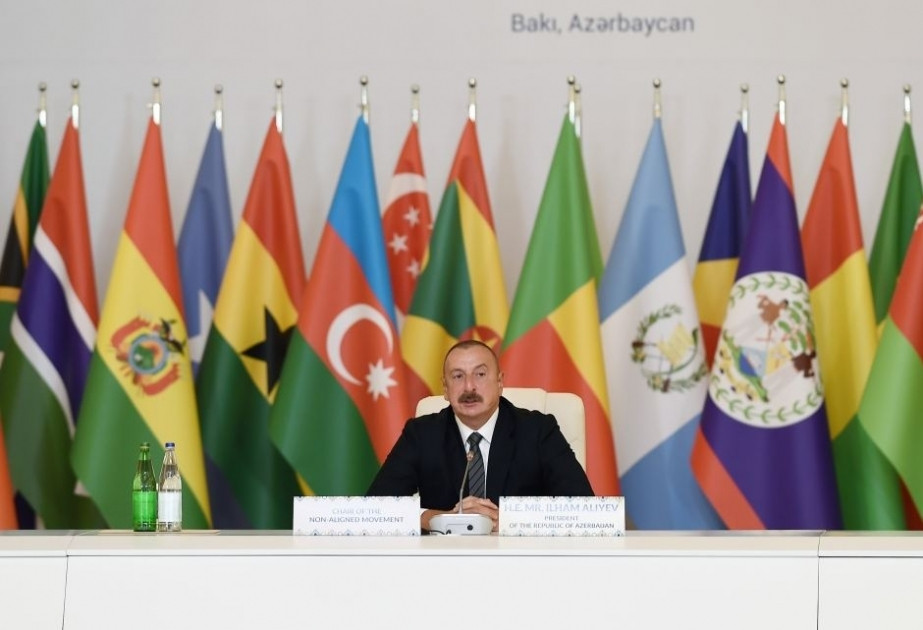Although rarely discussed in media, the Non-Alignment Movement (NAM) is an international organization uniting 120 member countries, and 17 observer countries and 10 international organizations. Based on the principles of non-participation in military blocs, it was formally established by 25 states, including India, Egypt, and the former Yugoslavia, at the Belgrade Conference in September 1961.
The NAM was once thought to have lost its relevance with the end of the Cold War but instead has gained a new momentum as a platform for cooperation among the member states in the face of a variety of challenges in a wide range of spheres, including security, economy and climate change.
Azerbaijan, a full member of the organization since 2011, is set to overtake leadership until 2022 at the organization at the 18th summit of the movement, which will take place on October 25th to 26th 2019 in Baku.
For a former Soviet republic, located in a highly sensitive geographic area — sandwiched between Russia in the North and Iran in the South —the opportunity of taking the leading position in an organization of 120 countries is hugely important and loaded with overarching implications for its regional and international policies.
Azerbaijan’s foreign policy principles, aptly formulated by Azerbaijani presidential aide on foreign policy, Hikmet Hajiyev, can be characterised as “4 Ms,” which stands for multi-vectorism, multilateralism, multi-regionalism and multiculturalism. According to Hajiyev, the geopolitical realities of the region and the location of Azerbaijan, gives Baku no choice but to develop partnership with various regional and global players rather than allying with one geopolitical pole at the expense of the country’s relations with other actors.
Notedly, unlike Belarus, another former Soviet statethat is member of NAM, along with Uzbekistan and Turkmenistan, Azerbaijan’s state constitution does not designate “neutrality” as a mandatory approach in international relations. But it was the challenges posed by regional instability and the loss of sovereignty over nearly 20 percent of the national territory to Armenia’s occupying forces that necessitated this strategy.
Non-alignment was adopted by Azerbaijan in the early years of the country’s post-Soviet independence under the former President Heydar Aliyev (1993-2003). He pursued so-called “balanced foreign policy” and thus departed from the unilateralist foreign policy of his predecessors, largely successful to adroitly maneuver in delicate power games in and around the region.
Hence, Azerbaijan’s non-alignment in the international sphere was not brought about by its membership in NAM, but vice-versa — the latter was the outcome of the country’s post-independence political preferences.
The organization, truly, provides a highly appropriate platform for Baku to promote its foreign policy vision and recruit international support for its non-aligned position amidst often dangerous confrontation between the west, Russia, Iran and the United States.
It is important to note that, Azerbaijan is the only South Caucasian republic that has opted for non-participation in military blocs, while Georgia has been passionately, albeit unsuccessfully, striving for NATO membership. Additionally, Armenia is a full member of the Russia’s NATO-like regional military bloc named Collective Security Treaty Organization.
As opposed to its neighbors, Azerbaijan has sought to develop its partnership with both Russia and the NATO, and was able to get its strategic choice to be accepted by the two rival powers. In the framework of its participation in NATO’s Partnership for Peace (PfP) program, Azerbaijani service members have served in NATO-led peacekeeping missions in Kosovo (KFOR) and Afghanistan (ISAF) since 2002. Azerbaijan continues to contribute to NATO’s “Resolute Support Mission” (RSM) by providing security at Kabul International Airport as well as checking passengers and cargo.
Undoubtedly, the resolution of the Armenia – Azerbaijan territorial conflict over the Nagorno-Karabakh and surrounding regions is also in the agenda of the Azerbaijan leadership in its activities concerning NAM.
The conflict between two South Caucasian republics, is already over 30 years old and appears to be a long way from peaceful resolution. Negotiations towards a settlement, brokered since the 1994 ceasefire agreement by the OSCE’s Minsk Group, co-chaired by Russia, the United States, and France, faces a stalemate that appears difficult, if not impossible, to overcome.
Under the existing circumstances, Azerbaijan treats the Non-Aligned Movement as an useful platform to draw attention to the regional reality generated by the occupation of one-fifth of its internationally recognised territories.
Over the last eight years of its membership, Azerbaijan has enjoyed the support of the organization on the Karabakh issue. In its 2016 summit in Isla de Margarita, Venezuela, NAM called for a resolution of the Armenian-Azerbaijani Nagorno-Karabakh conflict within Azerbaijan’s sovereign and internationally recognised borders.
But Azerbaijan also desires to empower the organization and help it become an influential global actor. Hikmet Hajiyev likewise, hopes that “the country’s chairmanship in the NAM in 2019-2022, will make significant contribution to the promotion of the goals and intentions of the NAM, strengthening of international peace, security and cooperation”.








